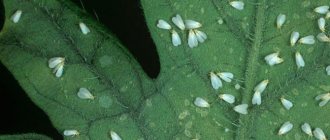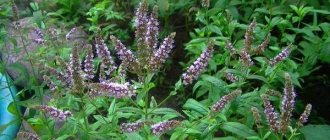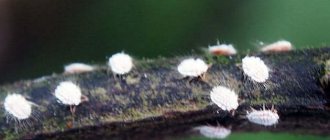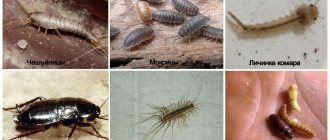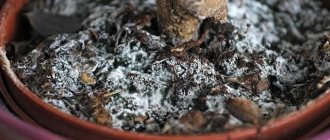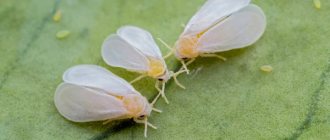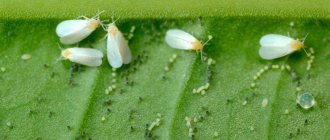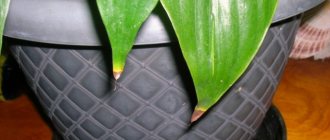It's hard to imagine an apartment without indoor plants on the windowsills or shelves.
But along with the pleasure of communicating with our green friends and colossal positive emotions comes the need to care for them and periodically save them from all kinds of pests of indoor plants.
Perhaps the most common phenomenon is midges in indoor flowers, hovering over potted plants, as well as small insects jumping on the surface of the soil in a pot.
In the first case, these are sciarids or, as they are also called, fungus gnats. In the second case - fools or earthen fleas.
What are earth fleas?
This type of flea got its name because of its habitat, but in appearance they are similar to their relatives that live on rats, dogs, cats and other animals.
What they look like
The body length of an adult flea reaches 2-3 mm. Males are smaller than females. The parasite is covered with a durable chitinous carapace of dark brown color. Its body is flattened laterally, which provides good streamlining when jumping.
The body of an insect, consisting of 3 sections, incl. head, chest and abdomen, characterized by an ovoid shape. The abdomen has the largest volume, because it fills with blood as the parasite feeds. The earth flea has 3 pairs of legs. They have serrations that help them cling to the fur and skin of the victim.
Only the hind legs - the longest ones - are used in jumping. The parasite covers a distance of 25-30 cm in one movement. It is believed that it is capable of jumping 75-100 cm in height. The flea, using its hind legs, shoots itself, so its jumps are chaotic.
Parasites have poor vision, but the sensory apparatus present on the back of the abdomen helps to detect even minor vibrations.
In addition, fleas are able to smell the blood and sweat of a victim at a distance of 2-3 m.
Adults have a piercing-sucking apparatus. When attacked, the parasite first pierces the skin and injects a special enzyme that prevents blood clotting and causes severe pain. After this, the flea expands the wound with blades and begins to feed, pumping blood into the expanding abdomen.
What do they eat?
Adults feed only on the tissue of warm-blooded animals. A flea can consume up to 1 ml of blood in one bite. For normal life, the parasite needs to feed at least once every 2-3 days. He makes many punctures on the skin of the legs until he finds a place where the vessels are located close to the surface.
How do they reproduce?
The breeding season for parasites lasts from mid-April to the end of September. During her life, a female can produce up to 500 eggs. Although adults are ready to mate immediately after emerging from the cocoon, the female must first find a warm-blooded animal and bite it. If the act of feeding has taken place, after about 48 hours the flea finds a secluded, cool place with a sufficient level of humidity and begins laying.
It can contain up to 40-50 eggs, covered with a special protective white shell. The eggs of parasites are oval in shape and their size does not exceed 0.1 mm. Under favorable conditions, larvae quickly emerge from them. In most cases it takes no more than 2-10 days.
Flea larvae resemble small worms covered with sparse hairs. They feed on decaying organic matter. After 7-21 days the larva pupates. A flea can spend from 7 to 200 days in the form of a pupa. If conditions are favorable, the insect quickly emerges from the cocoon, becoming an adult.
How long do they live?
Life cycle of a flea.
The lifespan of a flea depends on external conditions. Individuals overwintering in deep layers of soil often die during frosty and snowless winters. Under favorable conditions, they can live 1.5-2 years.
Preventive measures
You can protect indoor plants and prevent pests by following certain preventive measures:
- Water the plants regularly, but do not allow the soil to become waterlogged;
- purchase soil for flowers only from trusted manufacturers;
- You should not fertilize the soil with organic compounds; for this purpose it is better to use special fertilizers;
- water the flowers only with clean water;
- the soil needs to be loosened periodically;
- remove old inflorescences and leaves from plants;
- Large plants should be replanted twice a year, and small ones - no more than once.
Photo of an adult fool with multiple magnification
To be fair, it should be noted that only some species of collembola are classified as pests. But there are springtails that eat nematodes and enchytraeids, thereby bringing benefits. Insects feeding on rotting organic matter improves soil formation. The white fool is one of those four species of “brothers” that stand out for their harmfulness from the more than 4 thousand that live on earth. We can talk about the danger of insects in the case of a sharp growth of the colony, when there is not enough rotting residue in the pots to feed, and the thinnest thread-like roots of the root system begin to be eaten. Most often, orchids, violets, and gloxinias fall into the risk zone.
Attention! The appearance of springtails in indoor flowers is an indicator of waterlogged soil in pots and flowerpots and improper care of plants.
Habitats
Ground fleas live in the soil . In winter, they bury themselves 15-20 cm into the ground and pupate. With the onset of warmth, they leave their cocoons and move to the upper layers of the soil. An increase in their numbers is observed when it rained for some time, and then the heat came. High air temperatures and high humidity are the most suitable conditions for these insects. Adult parasites begin to search for a victim.
Fleas don't only live in the ground. They can be found and reproduce in human homes. They live in rooms with high humidity. They attack apartments on the first floors. They are especially common in homes where people neglect sanitary standards.
Good hiding places for them:
- a pile of clothes;
- cracks in the floor;
- folds of upholstered furniture;
- long carpet pile, etc.
In addition, fleas choose outbuildings. They live in animal bedding and places where old things are stored.
Drying
It is impossible to get rid of dura in an orchid, ficus, gardenia, and Dieffenbachia without thoroughly drying the soil in the pot. The soil is dried thoroughly, to a powdery state: the pot should become much lighter than its original weight. If dracaena, lemon and other indoor crops withstand a lack of moisture, then azalea and gardenia immediately begin to shed their leaves and dry out. Therefore, the process is controlled for each plant separately. The roots removed from the soil are carefully examined, and putrefactive, damaged areas are removed.
Attention! Excessive soil moisture is not always a sign that soil podura or other bugs necessarily live in it. There are never any of them in pots with moisture-loving cyperus, just as there are no rotting organic matter.
The danger of insect bites for humans
Biting insects such as fleas are extremely dangerous because... are carriers of many infectious diseases that require long-term treatment.
Among them:
- plague;
- encephalitis;
- listeriosis;
- anthrax;
- typhus;
- tuberculosis;
- hepatitis;
- tularemia.
Flea bites.
Flea bites are a source of helminthic and fungal infestation. The parasite injects its saliva during feeding. The bite site is very itchy and may become red. People who are sensitive to the enzymes present in the saliva of these fleas may experience allergic reactions.
First aid
The feet, ankles and ankles are the most common sites where the legs are affected. Areas of insect attack may be invisible, but damage to the skin is indicated by itching. If there are no severe allergic reactions, bites can be treated at home.
The affected area must be treated with a disinfectant. A cold compress helps relieve itching. In addition, it is recommended to use an ointment that includes antihistamines. If signs of allergy or intoxication of the body appear, you cannot carry out treatment on your own; you should seek medical help.
If fleas have bitten a child
Focal redness appears on children's skin at the sites of bites. The child experiences severe discomfort due to itching. Bite areas must be treated with a disinfectant and a cold compress applied. If there are many areas of damage, you should consult a doctor, because... Antihistamines may be required to relieve symptoms.
Midges in indoor flowers
Parasites often appear in plants in winter. It is at this time that the plants are weak. When small midges are found in indoor plants, first of all you need to determine to what stage the damage to the flower has reached. Damage is caused both by the insects themselves and their larvae. If you do not immediately resort to any measures, the flower will die.
Initially, it is recommended to dig out the soil in the flower pot and make sure that there are no fly larvae there. After all, getting rid of midges is much easier than getting rid of their larvae.
Methods of disposal
If the number of fleas in a residential area is small, you can fight them with chemical insecticides. There are many effective means that can be used to poison these insects, but when using them, some precautions should be taken to avoid poisoning. If this option is undesirable, you can use folk remedies to kill fleas.
In apartments on the first floors, even with the use of folk and chemical remedies, fleas appear again after a short time. This indicates that the basement is infested with them. In this case, fighting with simple methods will not help and you should turn to professionals to thoroughly disinfect not only the apartment, but also the areas underneath it.
Professional pest control
Professional pest control is the most effective. Experts agree to poison insects even in large rooms. They use special equipment and potent insecticides that can destroy not only adults, but also eggs, larvae and pupae. Many companies provide a guarantee for their services and, if necessary, carry out repeated disinfestation free of charge.
Chemicals
The most common method of killing fleas is to treat the premises with chemical insecticides. They are available in the form of powders, concentrates, aerosols, drops, and emulsions.
Option for a remedy for earthen fleas.
Insect control can be carried out with the following drugs:
- "Clean house".
- “Butox 50”.
- "Raptor".
- “Ecokiller”.
- "Phenaxin".
- “Nats.”
- "Raid".
- "Combat".
- "Dichlorvos".
It is difficult to determine which product is the best. One treatment with any of these drugs does not always give a good result, because... they are unable to destroy flea eggs. To achieve a positive effect, it is advisable to carry out 2-3 procedures with an interval of 5 days.
Folk remedies
Folk remedies that help repel fleas are recommended to be used when the number of insects in the house is small. To poison parasites, you can prepare a mixture of soda and salt. The components are taken in equal proportions. The composition should be thoroughly treated with all carpets and sprinkled in corners and on the floor in the basement. Turpentine can be used to treat outbuildings.
Herbal products are also effective in controlling fleas. A decoction of wormwood and tansy helps to quickly eliminate parasites. To prepare it, 2 cups of wormwood are mixed with 1 cup of tansy and 1 cup of eucalyptus.
The composition must be filled with 10 liters of hot water. The mixture is boiled for 3-5 minutes. After this, the container with it is removed from the heat, wrapped in a blanket and left to infuse for a day. The finished product should be filtered, poured into a spray bottle and used to treat the room.
To repel fleas, it is recommended to place spruce and pine branches in the corners of the living room. These insects cannot tolerate the smell of pine needles. To treat the room, brewer's yeast and garlic are used, mixed in equal proportions. The mixture should be rubbed onto all places where fleas can enter the house.
Folk remedies for fleas.
Exterminators
When an infection reaches terrifying proportions, you cannot hesitate, you need to call in professionals. Nowadays, there are many services that professionally carry out pest control of premises, eliminating pests for a long time. In addition, such services provide a guarantee that the insects will not return again. Of course, this will require certain financial costs, but the result will please you for a long time. Therefore, if you find large clusters of parasites, we advise you not to put off calling specialists.
Preparing the premises
An important condition for achieving a good result is careful preparation of the room for processing. All unnecessary old things and garbage should be thrown away. It is advisable to vacuum the floor. It is recommended to knock out carpets. In addition, be sure to treat all surfaces with soapy water.
Furniture should be immediately coated with special agents that repel parasites. Products must be refrigerated during disinfection to prevent chemicals from coming into contact with them. After this, you should close all windows tightly and begin processing the room.
Prevention of occurrence
Following preventive measures will help prevent the occurrence of fleas in the future.
Moreover, such events are necessary even for those people who wonder whether earthen fleas exist in their home.
But what will repel earth fleas?
Leading preventive methods to prevent the appearance of parasites:
- Every week you need to do a wet cleaning of your home, paying special attention to hard-to-reach areas.
- Brush and wash outdoor shoes regularly.
- Treat pets and let pets outside with a protective collar.
- Periodically wash floors with water and vinegar.
- Every 3 days you need to ventilate the room.
- Clean carpets regularly with special products.
Causes
1. Excess moisture
Excessively moist soil is a favorite habitat and breeding ground for insects. If you do not want midges to appear in the flower, irrigate the plants moderately and as needed.
2. Poor quality soil
Poor quality soil itself can become a haven for larvae. If you add such soil to a growing flower, you will quickly infect the plant and contribute to the development of midges.
3. Transplanting into huge pots
Do not replant plants “for growth”, as this is fraught with the appearance of midges. The root system will not reach the bottom of the pot, so excess moisture will accumulate at the bottom. And this is a favorite environment for small pests.
4. Use organics
Organic fertilizers also have a downside - they are good for plants, but attract harmful midges.
5. Visiting guests
Midges may seek warm shelter and fly into your home. And then find a plant with waterlogged soil and settle in it.
Why are uninvited guests dangerous?
Indoor plants are both a home and a source of food for midges.
Insects feed on sap from stems and leaves and infect the roots. Because of this, the infected plant withers. Its foliage becomes limp and it reacts poorly to feeding. And then it dies completely.
The result of exposure to scale insects
In addition, when feeding on juices, pests leave microscopic wounds on stems, leaves and roots. Through these wounds, flowers become infected with fungal, bacterial and infectious diseases. Their carriers, by the way, are the same flower midges.
That is why, simultaneously with parasites, flowers often suffer from various fungal diseases. But not every plant can withstand such a double blow to the immune system.
IMPORTANT! If midges are not dealt with, they will very quickly spread throughout the house. And instead of just one sick pet, you get an epidemic.
How to get rid of cat and dog fleas
Of course, the first people we attack when we see pests are our pets. In addition to the fact that bloodsuckers fill the entire apartment, our furry pets also suffer.
If your pet has become irritable and nervous, refuses to eat food, constantly itches, especially scratching its neck, ears and head, then there is a high probability that the pet has parasites.
You can confirm the presence of bloodsuckers by carefully examining the fur of a cat or dog. You will immediately notice black bugs running fast. And if you start washing the animal, the individuals usually “save themselves” by running over their heads.
Remedies for fleas on pets are very varied. They differ in type, method of application, duration of action. Let's look at the most common means.
Aerosols. Very effective, but very toxic. Considering that dogs and cats lick fur, poison can get inside, and the animal can become poisoned. Therefore, you need to use them with caution and carefully monitor your pet.
Shampoo. Pet stores and veterinary pharmacies will help you choose the right shampoo for your pet.
Drops. Most often, the drops need to be applied to the withers, so the animal will not be able to reach the active substance and lick it off, and the effect will be more pronounced.
Collars. The effect of the substance is weak, so collars are used as an additional measure, as well as as a preventive measure.
Hairy aphid
This type of aphid is also called mealybugs. They are one of the most dangerous insects for plants. As a rule, they can be found on the underside of leaves. Their presence is indicated by a cobweb-like white coating, as well as the presence of a sticky liquid.
These insects are distinguished by a high degree of fertility. Female mealybugs lay eggs in miniature formations that resemble balls of cotton wool. After a certain time, fairly mobile larvae emerge from these lumps, which are then distributed throughout the plant. Fighting them requires an instant reaction. The sooner you start fighting this pest, the greater the chance of saving the plant.
Armored mites
These pests are most familiar to orchid lovers, and they look similar to the regular small brown mites that hop around the stems and leaves of the plant. In reality, they are practically not dangerous for flowers, but they can carry the larvae of other pests, and in general they are not very pleasant. For control, we recommend using special acaricides, because ticks are very tenacious and adapt well to anything.
